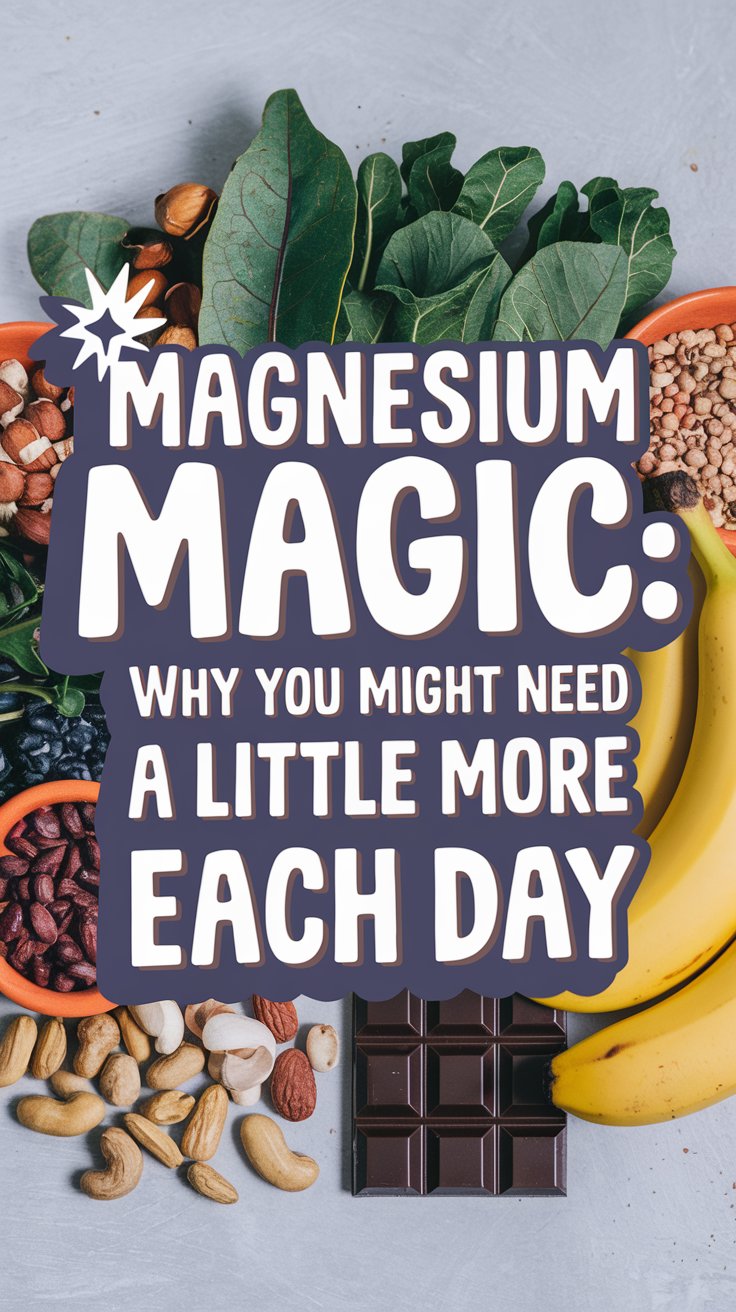
Please note: This website contains affiliate links. As an Amazon Associate, we earn from qualifying purchases at no additional cost to you.
Magnesium deficiency is more common than many realize, with significant portions of the U.S. population not meeting recommended intake levels. Estimates suggest that between 68% to 75% of Americans have a magnesium deficiency. That’s incredible, right?
So while magnesium might not get the spotlight like protein or vitamin C, but this quiet overachiever is essential for pretty much everything your body does. From keeping your heart beating smoothly to helping you relax at night, magnesium is the ultimate multitasker in the mineral world.
But here’s the thing—many of us are unknowingly walking around with less magnesium than we need. If you’re feeling tired, moody, or just not quite yourself, low magnesium might be part of the reason.
Let’s dive into the magic of magnesium—how to spot a deficiency, the benefits it brings, the different types of supplements, and how to get more of it naturally.

Signs You Might Be Low on Magnesium
Magnesium deficiency is sneaky. It doesn’t always announce itself with flashing lights, but your body does send signals if you know what to look for.
Common Signs of Magnesium Deficiency:
- Muscle Cramps or Twitches – If your calves are cramping in the middle of the night or your eyelid won’t stop twitching, your magnesium stores might be low.
- Fatigue and Weakness – Feeling constantly drained? Magnesium helps with energy production, so a deficiency can leave you feeling sluggish.
- Trouble Sleeping – Magnesium plays a big role in relaxation and sleep quality. Low levels can lead to tossing, turning, and Netflix marathons at 3 AM.
- Anxiety or Mood Swings – Magnesium influences neurotransmitters that regulate mood. Feeling anxious or down for no reason? This could be part of the puzzle.
- Headaches or Migraines – Low magnesium levels are linked to increased headaches and migraines.
- Irregular Heartbeat – Magnesium helps regulate your heartbeat. If you feel like your heart is doing a little tap dance, it might be worth checking out.
The Benefits of Magnesium (Why You Need It)
So, why all the fuss about magnesium? Because it’s involved in over 300 biochemical reactions in your body. Yeah, it’s kind of a big deal.
Key Benefits of Magnesium:
- Boosts Energy Levels – Magnesium helps convert food into energy, keeping you from hitting that mid-afternoon slump.
- Supports Muscle and Nerve Function – It keeps your muscles happy and less likely to cramp.
- Improves Sleep – Magnesium promotes relaxation by regulating melatonin and calming the nervous system.
- Reduces Stress and Anxiety – It plays a role in reducing cortisol (the stress hormone) and supports a calm, balanced mood.
- Promotes Heart Health – Magnesium regulates blood pressure and supports overall cardiovascular health.
- Strengthens Bones – It works with calcium and vitamin D to keep your bones strong and resilient.
- Helps with Digestion – Magnesium keeps things moving in the digestive tract, preventing constipation.
Types of Magnesium Supplements (Which One is Right for You?)
Not all magnesium supplements are created equal—some are better for muscle recovery, others for digestion or relaxation. Here’s a quick cheat sheet to help you choose:
- Magnesium Glycinate – Best for anxiety, relaxation, and sleep. It’s gentle on the stomach and easily absorbed.
- Magnesium Citrate – Popular for digestion and relieving constipation. Acts as a mild laxative.
- Magnesium L-Threonate – Known for improving brain health, memory, and focus. It’s one of the few forms that crosses the blood-brain barrier.
- Magnesium Malate – Great for energy and muscle pain. Often recommended for people with fatigue or fibromyalgia.
- Magnesium Oxide – Common and affordable but not as easily absorbed. Used primarily for heartburn and indigestion.
- Magnesium Chloride – Often found in oils or sprays, this form is absorbed through the skin and can help with muscle soreness and relaxation.
Magnesium Cheat Sheet
| Type of Magnesium | Best For | Notes |
|---|---|---|
| Magnesium Glycinate | Anxiety, relaxation, and sleep | Gentle on the stomach and easily absorbed |
| Magnesium Citrate | Digestion and relieving constipation | Acts as a mild laxative |
| Magnesium L-Threonate | Brain health, memory, and focus | Crosses the blood-brain barrier |
| Magnesium Malate | Energy and muscle pain | Often recommended for fatigue or fibromyalgia |
| Magnesium Oxide | Heartburn and indigestion | Common and affordable but less easily absorbed |
| Magnesium Chloride | Muscle soreness and relaxation (topical use) | Typically found in oils or sprays for transdermal absorption |
Choosing the Right Supplement: When selecting a magnesium supplement, consider the following factors:
- Bioavailability: Opt for forms that are easily absorbed by the body, such as magnesium citrate or glycinate.
- Purpose: Align the supplement type with your specific health needs—e.g., magnesium citrate for constipation relief or magnesium glycinate for sleep support.
- Quality: Choose products from reputable brands that undergo third-party testing to ensure purity and potency.
Consulting with a Healthcare Professional: It’s advisable to consult with your doctor before starting magnesium supplementation, especially if:
- Existing Health Conditions: You have kidney disease, heart issues, or other chronic health concerns that could be affected by increased magnesium intake.
- Medication Interactions: You’re taking medications that may interact with magnesium, such as certain antibiotics or diuretics.
- Uncertain Dosage: You’re unsure about the appropriate dosage for your specific health needs.
By considering these factors and seeking professional advice, you can make informed decisions about magnesium supplementation to support your overall health.
Foods Naturally High in Magnesium

If supplements aren’t your thing, no worries—nature’s got you covered. These magnesium-rich foods are easy to add to your daily meals.
Top Magnesium-Rich Foods:
- Leafy Greens – Spinach, kale, and Swiss chard are packed with magnesium (and other nutrients).
- Nuts and Seeds – Almonds, cashews, and pumpkin seeds are magnesium superstars.
- Avocados – As if you needed another reason to love avocado toast.
- Dark Chocolate – Good news! Dark chocolate (70% or higher) is a great source of magnesium.
- Bananas – They’re not just for potassium—bananas also contain magnesium.
- Legumes – Black beans, lentils, and chickpeas are full of fiber and magnesium.
- Whole Grains – Brown rice, oats, and quinoa provide a solid magnesium boost.
- Fish – Salmon and mackerel are not only rich in omega-3s but also magnesium.
How to Get More Magnesium (Without Overthinking It)
Getting more magnesium doesn’t have to mean a radical diet overhaul.
Simple Ways to Boost Magnesium Intake:
- Toss pumpkin seeds into your yogurt or salad.
- Swap regular rice for quinoa a couple of times a week.
- Add spinach or kale to your morning smoothie.
- Snack on a square of dark chocolate (you’re welcome).
- Roast some almonds or cashews for an easy grab-and-go snack.
Magnesium FAQs
How much magnesium do I need daily?
For most adults, the recommended daily amount is around 310-420 mg depending on age and gender.
According to the National Institutes of Health, “your body needs 400 to 420 milligrams per day for adult men and 310 to 320 milligrams for women (more if pregnant or breastfeeding).” It can vary slightly based on your age, so be sure to check out their recommended dosage chart.
Can you get too much magnesium?
From food? Not really—your body naturally filters out excess. But supplements in high doses can cause diarrhea or cramping. Stick to the recommended dose unless advised by a healthcare professional.
Per the NIH Office of Dietary Supplements, “too much magnesium from food does not pose a health risk in healthy individuals because the kidneys eliminate excess amounts in the urine, however, high doses of magnesium from dietary supplements or medications often result in diarrhea that can be accompanied by nausea and abdominal cramping.”
Who is at risk of magnesium deficiency?
People with digestive issues, diabetes, alcohol dependency, or those who eat a highly processed diet are at higher risk.
According to Verywell Health, “this widespread deficiency is often linked to diets high in processed foods and low in magnesium-rich options. Additionally, certain groups, such as individuals with gastrointestinal diseases, type 2 diabetes, or those consuming diets high in processed foods, may be at increased risk for magnesium deficiency.”
When should I take magnesium—morning or night?
For relaxation and sleep, take it at night. For energy and muscle function, morning or midday is fine.
Is magnesium safe for kids?
Yes, but the dosage varies. Always check with a pediatrician before giving any supplements to children.
Final Thoughts
Magnesium might not be flashy, but it’s essential for overall health and well-being. From calming nerves to improving sleep and boosting energy, this mineral does it all. Whether you get it through food or supplements, making sure you have enough magnesium can make a noticeable difference in how you feel every day.
Please note: This website contains affiliate links. As an Amazon Associate, we earn from qualifying purchases at no additional cost to you.











